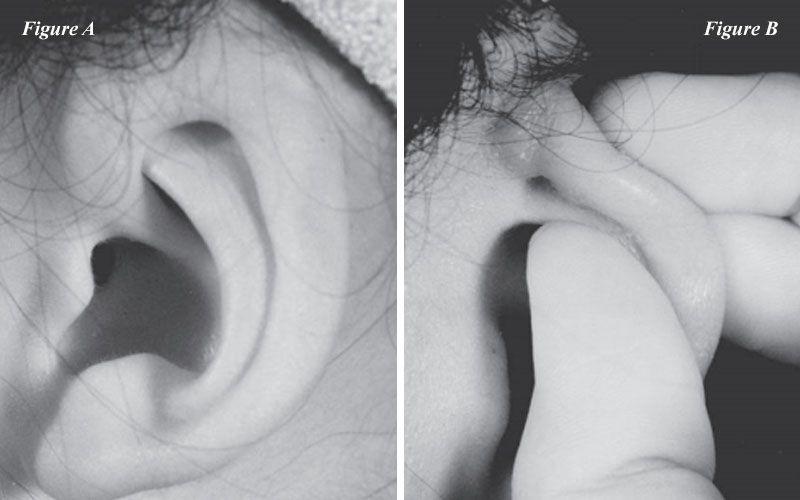Cryptotia is a malformation of the ears that is also known as "buried ear" or "hidden ear." This condition is a congenital deformity that causes the upper third of the ear to be hidden underneath the skin of the scalp. Typically, the cartilage of the ear is present, but is trapped beneath the temporal epidermis. Cryptotia is the fourth most common type of ear deformity in newborns. While this condition typically does not affect hearing, it can make wearing eyeglasses or sunglasses nearly impossible and significantly impact a child's self-esteem. Dr. Charles Thorne can perform surgical treatments for patients suffering from cryptotia at his New York City practice. These treatments involve minimal recovery and scarring and can provide effective results.

Cryptotia of the left ear causing cartilage to be hidden under temporal skin. Surgical results (right) freed the cartilage and recreated the auriculocephalic sulcus.
The cause of cryptotia is not known, but is not believed to be inherited or caused by other conditions. It has been considered that this deformity is caused by anomalies in the intrinsic transverse and oblique auricular muscles. The condition has also been present in patients suffering from Fraser cryptophthalmos syndrome and trisomy 18. While cryptotia is not particularly common, it has been shown to be more common in babies of Asian descent. In Japan, for example, as many as 1 in 400 babies is born with the condition. This is a significantly higher ratio than is present in predominantly Caucasian populations.
Cryptotia is typically obvious from birth. While some doctors or parents may believe the infant has ears that are smaller than average, physical examinations and pulling on the ear can reveal cartilage beneath the skin. In some cases, the upper cartilage of the ear will also be deformed. Cryptotia typically results in vertical deficiency while horizontal development is rarely affected. One of the major signs of the condition is the lack of an auriculocephalic sulcus, or the groove between the ear and the skull.
While cryptotia may not affect hearing, it could make wearing glasses difficult if they are needed later in life. Parents should also take into consideration the impact it could have on the child’s self-esteem. If treated early, typically within months of birth, non-surgical molding techniques can often effectively treat the condition without scarring. However, in children four and older, surgical procedures may be necessary to achieve the best results.
Typically, children who are four years of age or older can undergo surgical treatment with Dr. Thorne and his team at Lenox Hill Hospital.
Surgical treatment of cryptotia aims to:
Typically, children who are four years of age or older can undergo surgical treatment with Dr. Thorne and his team at Lenox Hill Hospital.
If your child was born with cryptotia, contact our office online or call (212) 794-0044 to schedule a consultation. Dr. Thorne can evaluate your child’s ears and determine the most appropriate techniques to correct the condition.

Dr. Thorne is the Editor-in-Chief and the author of several chapters in Grabb and Smith's PLASTIC SURGERY, 7th Edition.
Ear Construction Chapter in PDF







